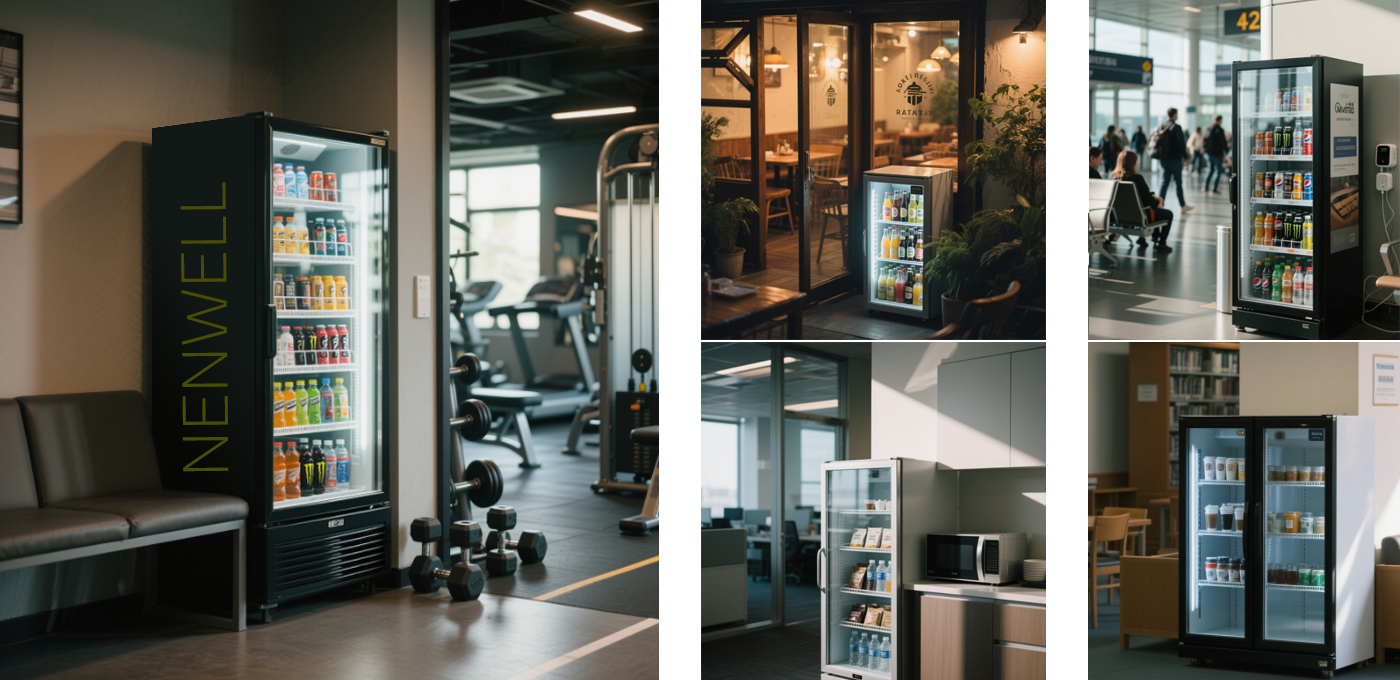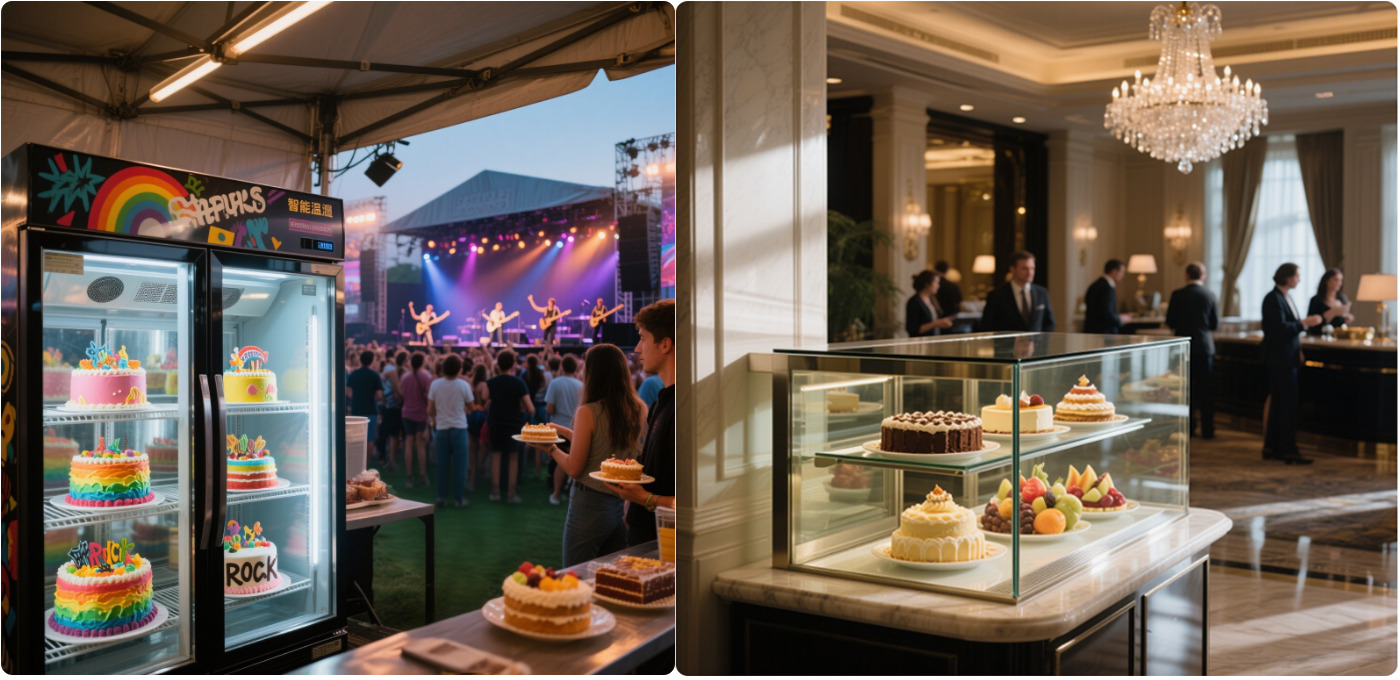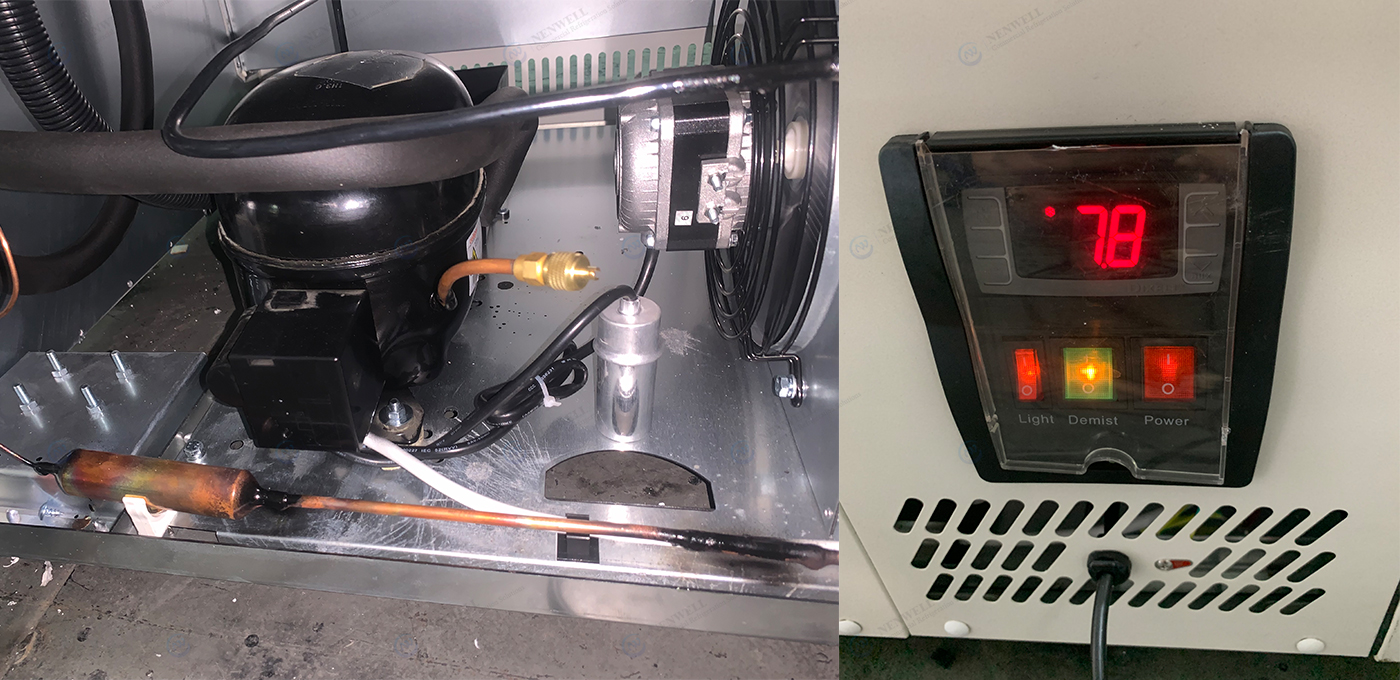In the operating costs of convenience stores and supermarkets, you will find that the energy consumption of refrigeration equipment accounts for as high as 35%-40%. As a core device with high-frequency use, the energy consumption and sales performance of beverage display cabinets directly affect the terminal profits. The “2024 Global Commercial Refrigeration Equipment Energy Efficiency Report” points out that the average annual power consumption of traditional beverage display cabinets reaches 1,800 kWh, while the glass door display cabinets with new energy-saving technologies can reduce energy consumption by more than 30%. Through the testing of more than a dozen cabinets, we found that scientific display design can significantly increase beverage sales by 25%-30%.
I. Core technological breakthroughs in reducing energy consumption by 30%
Generally, reducing energy consumption requires solving power consumption problems by combining system upgrades, optimizing system refrigeration and other core technologies. At present, with a qualitative leap in technology, reducing energy consumption by 30% poses certain challenges!
Sealing system upgrade: A qualitative change from “cold leakage” to “cold locking”
The daily cold loss rate of traditional open beverage cabinets reaches 25%, while modern glass door display cabinets achieve a revolutionary breakthrough through triple-sealing technology:
1. Nano-coated glass
The low-emissivity (Low-E) glass developed by the German company Schott can block 90% of ultraviolet rays and 70% of infrared radiation at a thickness of 2mm. With the argon gas filled in the hollow layer, the heat transfer coefficient (U value) is reduced to 1.2W/(m²·K), a 40% reduction compared to ordinary glass. The measured data of a certain chain supermarket shows that for the display cabinet using this glass, in a room temperature environment of 35°C, the temperature fluctuation range inside the cabinet is reduced from ±3°C to ±1°C, and the start-stop frequency of the compressor is reduced by 35%.
2. Magnetic suction sealing rubber strip
Made of food-grade ethylene propylene diene monomer (EPDM) material, combined with an embedded magnetic strip design, the sealing pressure reaches 8N/cm, a 50% increase compared to traditional rubber strips. The data from a third-party testing agency shows that the aging cycle of this type of rubber strip in an environment of -20°C to 50°C is extended to 8 years, and the cold leakage rate is reduced from 15% of the traditional solution to 4.7%.
3. Dynamic air pressure balance valve
When the door is opened or closed, the built-in sensor automatically adjusts the internal air pressure of the cabinet to avoid cold air overflow caused by the internal and external pressure difference.Actual measurements show that the cold loss during a single door opening has decreased from 200 kJ to 80 kJ, which is equivalent to a reduction of 0.01 kWh of electricity consumption per door opening and closing.
Refrigeration system optimization: The core logic of increasing the energy efficiency ratio by 45%
According to the data of the China National Institute of Standardization, the energy efficiency ratio (EER) of the new glass door beverage display cabinets in 2023 can reach 3.2, a 45% increase compared to 2.2 in 2018, mainly due to three major technological upgrades:
1. Variable frequency compressor
Adopting the DC variable frequency technology of brands such as Nenwell and Panasonic, it can automatically adjust the rotation speed according to the load. During low-traffic periods (such as in the early morning), the energy consumption is only 30% of the full load. The Actual measurement of convenience stores shows that the daily power consumption of the variable frequency model is 1.2 kWh, a 33% savings compared to the fixed frequency model (1.8 kWh per day).
2. Surrounding evaporator
The area of the evaporator is 20% larger than the traditional solution. With the optimization of the internal fin structure, the heat transfer efficiency is increased by 25%. The test data of the American Society of Heating, Refrigerating and Air-Conditioning Engineers (ASHRAE) shows that this design improves the temperature uniformity inside the cabinet from ±2°C to ±0.8°C, avoiding the frequent startup of the compressor caused by local overheating.
3. Intelligent defrosting system
The traditional mechanical defrosting starts 3 – 4 times every 24 hours, each time taking 20 minutes and consuming 0.3 kWh of electricity. The new electronic defrosting system dynamically judges the degree of frosting through a humidity sensor. The average daily defrosting times are reduced to 1 – 2 times, and the single-time consumption is shortened to 10 minutes, saving more than 120 kWh of electricity annually.
II. The golden rules of display design to increase sales by 25%
Increasing sales requires important design rules, that is, the golden rules are solutions that fit the times. Different layouts and plans can efficiently improve performance and also bring a better user experience. Humans have always focused on the principle of user-friendliness and continuously broken through the limitations of rules to create more miracles.
(1) Visual marketing: The transformation from “presence” to “purchase desire”
According to the “sight economics” theory in the retail industry, the click-through rate of products in the height range of 1.2 – 1.5 meters is 3 times that of the bottom shelves. A certain chain supermarket set the middle layer (1.3 – 1.4 meters) of the glass door display cabinet as the “blockbuster area”, concentrating on displaying popular online beverages with a unit price of $1.2 – $2. The sales volume of this area accounts for 45% of the total, an increase of 22% compared to before the transformation.
From the perspective of the light matrix design, warm white light (3000K) has the best color restoration for dairy products and juices, while cold white light (6500K) can better highlight the transparency of carbonated beverages. A certain beverage brand jointly tested with a supermarket and found that installing a 30° inclined LED light strip (illuminance 500lux) at the top of the inner side of the glass door can increase the attention of single products by 35%, especially for packaging with a metallic luster on the bottle body, and the reflective effect can attract the attention of customers 5 meters away.
The dynamic display template: Adopting adjustable shelves (with a layer height freely combinable from 5 – 15cm) and a 15° inclined tray, the label of the beverage bottle body and the line of sight form a 90° angle. The data of Walmart in China shows that this design shortens the average picking time of customers from 8 seconds to 3 seconds, and the repurchase rate is increased by 18%.
(2) Scenario-based display: Reconstructing the consumer decision-making path
1. Time-period combination strategy
During the breakfast period (7 – 9 am), display functional beverages + milk combinations on the first layer of the display cabinet. During the lunch period (11 – 13 pm), promote tea beverages + carbonated beverages. During the dinner period (17 – 19 pm), focus on juices + yogurt. After a certain community supermarket implemented this strategy, the sales volume during non-peak hours increased by 28%, and the average customer price increased from $1.6 yuan to $2 .
2. Combined with hot events
Combined with hot events such as the World Cup and music festivals, post theme posters on the outside of the display cabinet and set up a “must-have for staying up late” area (energy drinks + electrolyte water) inside. The data shows that this kind of scenario-based display can increase the sales volume of related categories by 40% – 60% during the event period.
3. Price contrast display
Display high-margin imported beverages (unit price $2 – $2.7) adjacent to popular domestic beverages (unit price $0.6 – $1.1). Using price comparison to highlight cost-effectiveness. The test of a certain supermarket shows that this strategy can increase the sales volume of imported beverages by 30% while driving the sales volume of domestic beverages to increase by 15%.
III. Practical cases: From “data verification” to “profit growth”
According to the data of Nenwell last year, reducing the cost of display cabinets can achieve higher profit growth. It is necessary to verify the reliability from data rather than through theory, as the latter brings greater risks.
(1) 7-Eleven Japan: A benchmark practice of double improvement in energy consumption and sales
In a 7-Eleven store in Tokyo, after introducing a new type of glass door beverage display cabinet in 2023, three core breakthroughs were achieved:
1. Energy consumption dimension
Through the variable frequency compressor + intelligent defrosting system, the annual power consumption per cabinet was reduced from 1,600 kWh to 1,120 kWh, a decrease of 30%, and the annual electricity cost savings was approximately 45,000 yen (calculated at 0.4 yuan/kWh).
2. Sales dimension analysis
By adopting a 15° inclined shelf + dynamic lighting, the monthly average sales amount of beverages in the cabinet increased from 800,000 yen to 1,000,000 yen, an increase of 25%.
3. User experience comparison
The temperature fluctuation inside the cabinet was reduced to ±1°C, the stability of the beverage taste was improved, and the customer complaint rate decreased by 60%.
(2) Yonghui Supermarket in China: The code for cost reduction and efficiency increase through localization transformation
Yonghui Supermarket piloted the upgrade plan of glass door display cabinets in its stores in the Chongqing area in 2024. The core measures include:
1. Measures for high temperature in summer
In view of the high temperature in summer in the mountain city (with an average daily temperature of above 35°C), a deflector was installed at the bottom of the display cabinet, which increased the cold air circulation efficiency by 20% and reduced the compressor load by 15%.
2. Localized display
According to the consumption preferences in the southwest region, the shelf spacing was expanded to 12cm to adapt to the display of large bottles (above 1.5L) of beverages. The sales proportion of this category increased from 18% to 25%.
3. IoT – based monitoring and adjustment
Through IoT sensors, the sales volume and energy consumption of each cabinet are monitored in real time. When the sales volume of a certain single product is lower than the threshold for 3 consecutive days, the system automatically triggers an adjustment of the display position, and the commodity turnover efficiency is increased by 30%.
After the transformation, the per – square – meter efficiency of the beverage area in the pilot stores increased from 12,000 yuan/㎡ to 15,000 yuan/㎡, the average annual operating cost per cabinet decreased by 22%, and the investment payback period was shortened from 24 months to 16 months.
IV. Purchase pit – avoiding guide: Three core indicators are indispensable
Common risks exist in energy efficiency, materials, and service systems. However, export display cabinets are up to standard, and it is difficult to fake in terms of materials. Attention should be paid to craftsmanship and quality, as well as after – sales service.
(1) Energy efficiency certification: Reject “false data labeling”
Recognize internationally recognized energy efficiency certifications such as Energy Star (USA) and CECP (China), and give priority to products with an energy efficiency grade of 1 (China standard: daily power consumption ≤ 1.0 kWh/200L). A certain unbranded display cabinet is marked with a daily power consumption of 1.2 kWh, but the actual measurement is 1.8 kWh, resulting in an annual additional electricity cost of over $41.5.
(2) Material selection: Details determine lifespan
Give priority to galvanized steel plates (coating thickness ≥ 8μm) or ABS engineering plastics, whose corrosion resistance is 3 times higher than that of ordinary steel plates.
Recognize tempered glass with 3C certification (thickness ≥ 5mm), whose explosion – proof performance is 5 times that of ordinary glass, avoiding the risk of self – explosion in high – temperature summers.
(3) Service system: The hidden killer of after – sales costs
Choose brands that provide “3 – year whole – machine warranty + 5 – year compressor warranty”. The maintenance cost of the compressor of a certain small – brand display cabinet after a failure reached 2,000 yuan, far exceeding the average annual maintenance cost of regular brands.
When the glass door beverage display cabinet transforms from a “big power consumer” to a “profit engine”, it is the in – depth integration of refrigeration technology, display aesthetics, and data operation behind it. For supermarket operators, choosing a display cabinet that combines energy – saving and marketing power essentially means investing 10% of the equipment cost to drive a 30% reduction in energy consumption and a 25% increase in sales – this is not only a hardware upgrade but also a profit reconstruction based on consumer insights.
Post time: May-12-2025 Views:



